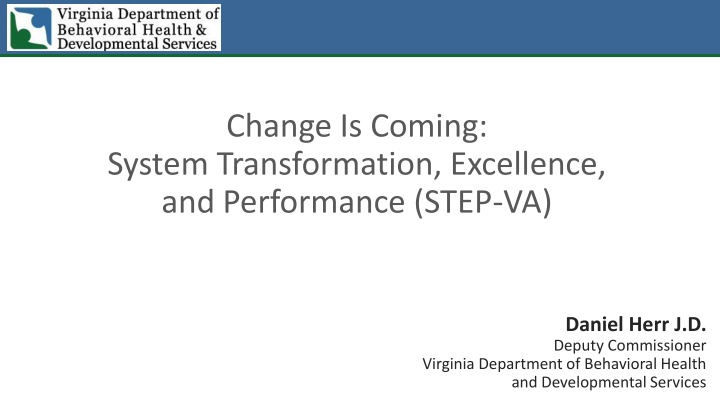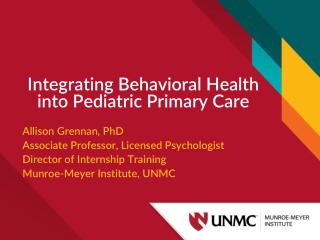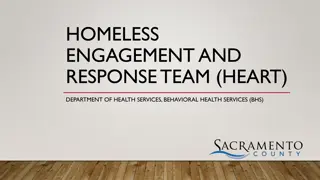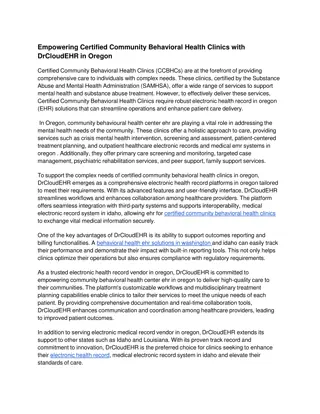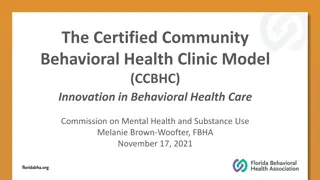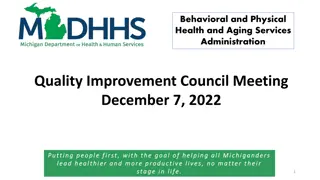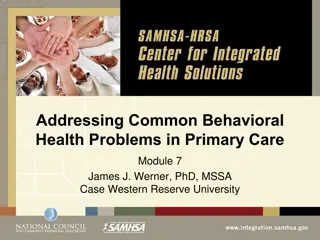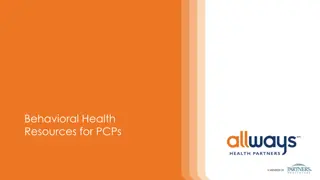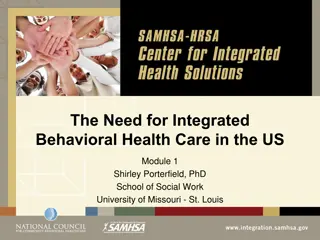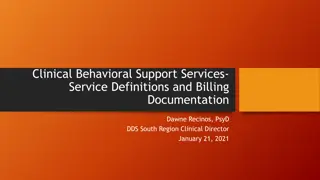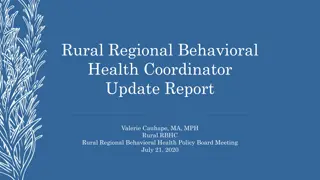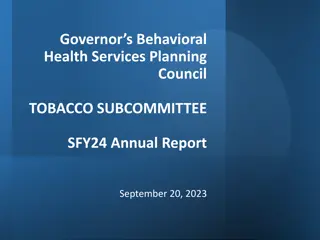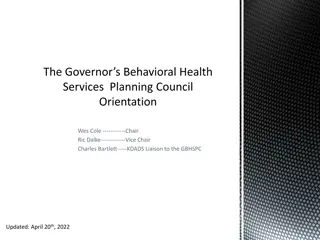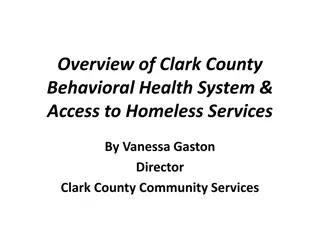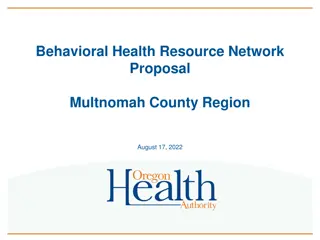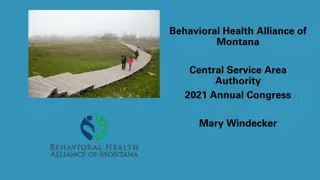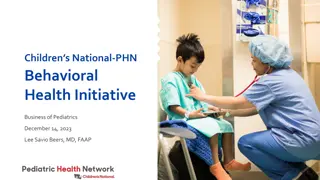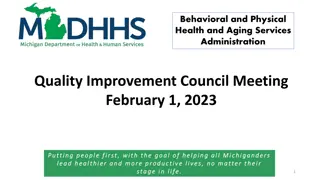System Transformation for Behavioral Health Services
This presentation delves into the need for change in Virginia's Behavioral Health system due to challenges like lack of primary care, funding misalignment, and high costs. It highlights the landscape of Behavioral Health services, focusing on the costs and services provided in FY 2017.
Download Presentation

Please find below an Image/Link to download the presentation.
The content on the website is provided AS IS for your information and personal use only. It may not be sold, licensed, or shared on other websites without obtaining consent from the author.If you encounter any issues during the download, it is possible that the publisher has removed the file from their server.
You are allowed to download the files provided on this website for personal or commercial use, subject to the condition that they are used lawfully. All files are the property of their respective owners.
The content on the website is provided AS IS for your information and personal use only. It may not be sold, licensed, or shared on other websites without obtaining consent from the author.
E N D
Presentation Transcript
Change Is Coming: System Transformation, Excellence, and Performance (STEP-VA) Daniel Herr J.D. Deputy Commissioner Virginia Department of Behavioral Health and Developmental Services
Section One WHY CHANGE IS NEEDED: THE CONTEXT
Challenging Road to Reforming Virginia s Behavioral Health System Crisis Focus Lack of Primary Care CSB Variability ADA/ Olmstead 50% Have No Payor Funding Alignment Burden and Cost of BH Care System of Pieces 40 CSBs/1,927 locations 631 private providers/4,131 locations CSB Variability Funding amount and type Population demographics Local priorities Service array Funding 25% State General Funds 23% Local Funds 40% Medicaid Funds 40% CSB clients lack payor source Crisis Focus 30% of services delivered are crisis services Slide 3
The Behavioral Healthcare (BH) Landscape BH issues drive up to 35% of medical care costs. Care for people with BH disorders costs up to 2-3 times as much as those without such disorders. State hospital capacity average: 15 beds per 100,000 people. National average of state spending on hospitals = 23% of overall BH budget. National average of state spending on community = 75% of overall BH budget (~$89 per capita, 2013). From 2009-2012, 12 states closed 15 state mental health hospitals. In 2013, VA was 31st in non- Medicaid GFs for BH at $92.58 per person. Median (Ohio) was $100.29 per person. Roughly 50% of GF dollars for BH supports 3% of persons served. State Hospital Capacity: 17.3 beds per 100,000 people. Virginia spending on hospitals = 49% of overall BH budget in FY18. Virginia spending on community = 48.5% of overall BH budget, FY18 ($47 per capita, 2013). Average 200 individuals ready for discharge in VA s mental health hospitals. VA has never closed a MH hospital. Slide 4
Virginias Behavioral Health Services (FY 2017) Individuals Served - Hospital & Community Spending - Hospital & Community State Mental Health Hospitals, 6,291, 2% 400,000,000 350,000,000 CSB Mental Health Services, 120,751; 38% $60,245,340 $54,353,341 300,000,000 CSB Substance Use Disorder Services, 30,549; 10% 250,000,000 200,000,000 CSB 150,000,000 $293,631,499 $282,629,155 Emergency Services, 62,391; 20% CSB Ancillary Services, 93,111; 30% 100,000,000 50,000,000 0 State Hospital Community General Fund Nongeneral Fund Slide 5
State Hospital Changes Due To Last Resort Legislation State Hospital TDO Admissions 10000 8000 6000 4000 2000 0 FY13 FY14 FY15 FY16 FY17 FY18 FY19 FY20 Since Last resort legislation was passed, a bed was provided for everyone under a TDO who needed a bed since the law was implemented July 1, 2014. Since FY 2013, TDO admissions have increased 294% . Since FY 2013, medical care costs have grown by more than 90%. In FY 2019, the trend continues as in prior years. Slide 6
Total TDOs and Hospital Admission Trends 30,000 25,852 25,798 25,576 24,889 25,000 22,687 20,000 22,322 21,861 20,220 15,000 10,000 5,356 4,397 3,497 5,000 2,192 0 FY15 FY16 Total TDOs Admitted to State Hospitals Total TDOs Admitted to Private Hospitals Total TDOs Issued FY17 FY18* Slide 7
Extraordinary Barriers to Discharge List (EBL) In September 2018, there were 158individuals in state hospitals who were clinically ready for discharge for more than 14 days but appropriate community services were unavailable to facilitate a safe discharge. This is 12 percent of the total statewide census. Because approximately 575 people are added every year, the EBL is increasing again. 250 Number of Individuals on the EBL 200 150 204 100 194 185 185 181 172 168 156 155 152 147 147 145 50 0 Slide 8
Workforce Challenges Direct care staff turnover is the highest in 10 years, a huge issue for state hospital census management. The average salary trails the national market. Hospitals are facing staffing shortages and overtime is increasing as a result. RN vacancy rate across nine hospitals is 28%; Direct care vacancy rate is 14.0%. CSBs are losing case managers to the Health Plans who are paying $10-15,000 more with other incentives. Pay not equal to workload" was among the top five reasons cited for leaving a case management position. State Hospital Staffing Vacancy Rates FY 18 CAT CSH CCCA ESH NVMHI PGH SVMHI SWVMHI WSH Direct Care DSAs Direct Care RNs 20% 13% 22% 19% 6% 28% 18% 9% 1% 17% 29% 20% 54% 19% 44% 12% 14% 36% RN = Registered nurse DSA = Direct service associate Slide 9
What Virginia Must Solve Must improve access to services across Virginia Over-reliance on crisis services ~50% of people served by CSBs lack coverage Health disparities (geographic, socioeconomic) ACCESS Over reliance on costly institutional care Consistent implementation of best practices Meeting Olmstead/ADA- Requiring integrated services QUALITY CSB services vary considerably across Virginia Size, geography, local funding, reimbursement disparities, local priorities, etc. CONSISTENCY Outdated data infrastructure and reporting Variances in governance, related to funding streams Quality/Performance/Engagement ACCOUNTABILITY Slide 10
Section Two THE CHANGES - STEP-VA - MEDICAID EXPANSION - FINANCIAL REALIGNMENT
Behavioral Health Services for Uninsured Virginians Three steps must be taken to transition Virginia s public safety net services: 2) Align DMAS managed care behavioral health programs with STEP-VA so the same metrics and standards apply to the care for both Medicaid members and the uninsured. 3) Address the bifurcated funding streams for CSBs and state hospitals to better align services with needs and achieve better cost efficiency. 1) Build/expand the services, access, and measures incorporated into STEP-VA. Slide 12
System Transformation, Excellence and Performance in Virginia (STEP-VA) Infuses the services to better manage symptoms, negotiate employment, manage time, develop and maintain relationships, and negotiate other real life problems in daily living. Reduces the demand for psychiatric and medical hospitalization. Addressing demand for state hospitals cannot be fully accomplished by implementing STEP-VA. Through STEP-VA and by expanding housing to target discharge-ready individuals in state hospitals, Virginia s imbalanced system shifts to stronger community services and more integrated housing and supports, more in line with other states. Slide 13
Implementation Dates for STEP-VA Services Required by VA Code (2017) GA Implementation Code Requirement July 1, 2019 July 1, 2019 July 1, 2021 July 1, 2021 July 1, 2021 July 1, 2021 July 1, 2021 July 1, 2021 STEP-VA Service Funds Allocated5.9 Same Day Access Primary Care Integration Behavioral Health Crisis Services Outpatient Behavioral Health Psychiatric Rehabilitation Peer/Family Support Services Veterans Behavioral Health Care Coordination Targeted Case Management (Adults and Children) 2018: $4.9M / 2019 $5.9M 2019 $3.7M / 2020 $7.4 2020 $2M for detox 2020 $15M July 1, 2021 Slide 14
Implementation of the First Steps Build Out Crisis Services Primary Care Screening & Monitoring Outpatient Services The 2018 General Assembly provided $2M in FY 2020 for detoxification services to help divert individuals from state hospital admission under the influence of substances during emergency services evaluation. The 2018 General Assembly provided $15M in FY 2020 for outpatient counseling services to allow the majority of people requesting services to be seen within 10 business days of the SDA appointment. Same Day Access CSBs will begin providing or expand this service in early 2019. By the end of 2018, all but 5 CSBs will have implemented Same Day Access. The remaining 5 will implement in early 2019. Slide 15
Same Day Access (SDA) A person calls or appears at the CSB and is assessed that day. Based on assessment is scheduled for appropriate treatment within 10 days. Shifts care away from crisis response when people are more at risk for themselves and for others. Requires a change in CSBs business practices, scheduling, documentation, caseload management, and utilization of more focused and practical therapies. Best practice that virtually eliminates no show appointments, increases adherence to follow-up appointments, reduces the wait time for appointments, and makes more cost-effective use of staff resources. Same DayAccess Average results seen by the National Council for Behavioral Health: o 60% reduction in wait times; greater engagement and reduced no-shows. o 39% reduction in cost of access to treatment process o 34% reduction in staff time needed per access to treatment event. o 9 hours per week in time saved per direct care staff on documentation. Slide 16
Sampling of Same Day Access Initial Results CSB Initial Results for Same Day Access Chesterfield Eliminated wait-lists. Has zero no-shows for assessments (means staff spend less time doing outreach and rescheduling people who do not follow through with services). Improved (lower) drop-out rates from assessment to admission. Blue Ridge Decreased intake time from 3-3.5 hours to 1.5-2 hours. Henrico Engagement improved with a substantial increase in the show rate to the program (2016: 56% show rate; 2017: 77% show rate). Large increase in clients entering into services compared to 2016. New River Valley Wait time for initial intake has gone from almost 4-6 weeks to 0 days; No show rate for first appointment from assessment has decreased from over 40% to 18%. Hanover Launched December 1, 2017. From Dec. 1 Dec. 29, there were 81 people who walked in for services. Slide 17
Primary Care Screening and Monitoring In 2017, the General Assembly required all CSBs to provide outpatient primary care screening and monitoring services by July 1, 2019. Primary care screening and monitoring for individuals seeking services from CSBs will increase the likelihood of those at risk of physical health issues getting preventative and primary care for physical health conditions. Care coordination is vital to ensure individuals are linked with health care providers and follow up is done to address any barriers to services to address health risks. People with severe mental illness (SMI) have an excess mortality, being two or three times as high as that in the general population. This ..translates to a 13-30 year shortened life expectancy in SMI patients About 60% of this excess mortality is due to physical illness. - Journal of World Psychiatry (Feb. 2011) Slide 18
Behavioral and Primary Healthcare Link Prevalence of Behavioral Health Comorbidities Among Medicaid-Only Beneficiaries with Disabilities Source: Center for Health Care Strategies, Inc. Slide 19
Behavioral and Primary Healthcare Link Impact of Behavioral Health Comorbidities on Per Capita Costs Among Medicaid-Only Beneficiaries with Disabilities Source: Center for Health Care Strategies, Inc. Slide 20
Re-envisioning the Future of Crisis Services Lifespan Support Cross Disability Comprehensive Array of Services Children Adolescents Adults Behavioral Health Developmental Disability Prevention Services Mobile Crisis Stabilization Children s Crisis Therapeutic Homes Provider Development Slide 21
Outpatient Mental Health and Substance Use Services Includes individual, family, and group psychotherapy and competent use of evidence based practices. Evidence based practices include but are not limited to: o Trauma Informed Care o Person and Family Centered Care o Recovery Oriented Care o Motivational Interviewing o Cognitive Behavioral Therapies (Trauma informed CBT for children) o Prescription long-acting injectable medications for mental and substance use disorders o Tobacco Cessation o American Society of Addiction Medicine ASAM Criteria o Medication Assisted Treatment Foundation for all services provided by the agency Slide 22
Targeted Case Management Assisting individuals in sustaining recovery, and gaining access to needed medical, social, legal, educational, and other services and supports. Supports for persons deemed at high risk of suicide, particularly during times of transitions such as from an ED or psychiatric hospitalization. Identifying and reaching out to individuals in need of services, Assessing needs and planning services, Linking the individual to services and supports, Assisting the individual directly to locate, develop, or obtain needed services and resources, Coordinate services with other providers, Enhancing community integration, Making collateral contacts, Monitoring service delivery, and Advocating for individuals in response to their changing needs. Slide 23
Psychiatric Rehabilitation Services Psychiatric Rehabilitation Services provide: o Assessment, o Medication education, o Opportunities to learn and use independent living skills o Enhance social and interpersonal skills, o Family support and education, o Vocational and educational opportunities, o Advocacy to individuals with mental health, substance use, or co-occurring disorders in a supportive community environment focusing on normalization. It emphasizes strengthening the individual s abilities to deal with everyday life rather than focusing on treating pathological conditions. Specific services to be provided include Mental Health Skill Building Services, Psychosocial Rehabilitation Services, and Intensive In-Home Services as defined in the current Virginia State Medicaid Plan. Slide 24
Peer and Family Support Peer Support and Family Support, including parent peer support for children, provides access to: o Peer specialists o Recovery coaches, o Peer counseling, o Family/caregiver supports including parent peer support partners. Peers will be certified through the DBHDS certification process. WRAP (Wellness Recovery Action Plan) or equivalent planning will be provided through peer and family support services. Recovery support services include: 1. Emotional support Includes peer mentoring, peer coaching, and peer-led support groups; 2. Informational support Includes peer-led life skills training, job skills training, citizenship restoration, educational assistance, and health and wellness information; 3. Instrumental support Includes connecting people to treatment services, providing transportation to get to support groups, child care, clothing closets, and filling our applications or helping people obtain entitlements; and 4. Affiliational support Offers the opportunity to establish positive social connections with other recovering people. Slide 25
Armed Forces and Veterans Intensive Community-Based Mental Health Care for Members of the Armed Forces and Veterans are not always easily accessible. Services are to be informed by SAMHSAs 10 guiding principles of recovery: o Hope o Person-driven o Many pathways o Holistic o Peer support o Relational o Culture o Addresses trauma o Strengths/responsibility o Respect Work to identify members of the armed forces and veterans upon intake to be sure they receive appropriate support and services. Slide 26
Care Coordination Care coordination includes but is not limited to: o Department of Social Services o Physical health care providers o Schools o Employment and o Housing resources Care coordination for youth in the CCBHC model is crucial given the many different entities serving children and adolescents and their families including physical health providers. The intensity of care coordination should be appropriate to the level of need and include High Fidelity Wraparound model when needed. Slide 27
Care Coordination Four key activities will be included in care coordination: 1. Assume accountability including a referral and transition tracking system. 2. Provide individual and family support during the referral and transition process. 3. Build relationships with community providers serving the same population and develop formal care coordination agreements with those providers. 4. Develop connectivity wherever possible for ease in exchange of medical information. Slide 28
Person-Centered Treatment Planning Engages the individual and family through emphasizing the uniqueness of each person and his or her right to self determination. Is based on principles of wellness, recovery, and hope and seeks to discover strengths that each individual possesses. Is the road map for the work done by the individual, family, and provider and addresses: o Strengths, Needs, Abilities, and Preferences of the individual. o Balancing strengths with barriers. o The Individual s life vision by incorporating his/her hopes, dreams, and goals. o The Integration of prevention, medical and behavioral health needs. o Safety and crisis planning. o All services required to help meet the identified goals o Individual s advance wishes related to treatment and crisis management Slide 29
Permanent Supportive Housing Chronic housing instability and homelessness are correlated with high health, behavioral health, and criminal justice system costs. Permanent Supportive Housing (PSH) combines affordable rental housing with supportive services to address the treatment, rehabilitative, and recovery support needs of adults with serious mental illness. Studies have found PSH effectively improves participants housing stability and reduces emergency department and inpatient hospital utilization. From FY 2015 FY 2018, DBHDS has received $9.3M for PSH. Approximately 391 individuals are currently housed and 310 additional individuals will be housed this fiscal year. Once the leases are completed, DBHDS will house and serve 700 people with serious mental illness through PSH funding. Institutional Use Housing Instability Slide 30
DBHDS PSH Providers by CSB Catchment Slide 31
What STEP-VA Addresses ACCOUNTABILITY Know what we are paying for, services provided, number of individuals served Expanded and improved data collection Uniform metrics, outcomes State certification required ACCESS CONSISTENCY Specific required services Uniform definition of services Full array of services for mental health & substance abuse needs Basic primary care assessment and linkage Important support services QUALITY Regardless of ability to pay (sliding scale fees) and place of residence At convenient times & places Prompt intake & engagement in services Crisis management 24/7/365 Prioritizes children, Veterans, SED, SUD, SMI Evidence-based practices Improved coordination and integration EHR/Data-quality improvement, reducing disparities & research Person/family centered, trauma informed, Culturally competent Recovery oriented care Slide 32
The Opportunity for Medicaid Redesign Medicaid is the largest payer of behavioral health services in Virginia 40th in the county for overall mental health outcomes $$$ 47th in the country for children s mental health outcomes of Medicaid members had either a primary or secondary behavioral health diagnoses 28% Slide 33
Farley Centers work in Virginia: Key Findings In FY17, 28% of Medicaid members had either primary or secondary behavioral health diagnoses 28% Among Medicaid community-based mental health services mental health skill building accounted for nearly 40% of the total expenditure, therapeutic day treatment for 29% and and intensive in- home for 20%. Medicaid members with behavioral health diagnoses had 1.34+ million visits across multiple care settings Slide 34
DBHDS/DMAS Vision of Redesign: A comprehensive spectrum of behavioral health services In collaboration with stakeholders clinical input, our goal is to develop recommendations for a comprehensive system redesign plan for Medicaid behavioral health services Our vision for this system: Improved behavioral health outcomes for members A shift in our collective energies Manifestation of trauma-informed principles across member, provider, and system Reflective of the evidence for what works in community mental health Mindful of the evolving needs for members across the lifespan
DBHDS/DMAS Work Process 1. Review best practices for Medicaid mental health services across the lifespan from research literature and state case studies Analyze service gaps for the Virginia Medicaid population Identify individual and population level metrics and quality outcomes Assess DBHDS licensing and regulations to ensure quality and accountability Enlist stakeholders input throughout process to shape recommendations for a continuum of care and next steps Develop recommendations for a continuum of evidence- based, trauma-informed, and preventive-focused Medicaid community mental health services 2. 3. 4. 5. 6.
Anticipated Outcomes Alignment: Recommendations to align Medicaid behavioral health services with DBHDS licenses to create a continuum of evidence-based, trauma-informed, prevention-focused and cost-effective service options for members across the lifespan Accountability: Recommendations on outcome measures that incentivize high quality services in least restrictive environments Access: Recommendations to expand access through a no wrong door approach for members across a full array of services delivered in settings where they naturally present for support. Recommendations to expand access to service types and therapeutic interventions that are best practices and well-matched to members level of impairment / support need.
General Assembly Requirement for Financial Realignment Plan This plan shall include (Item 284 E.1.): i. a timeline and funding mechanism to eliminate the extraordinary barriers list and to maximize the use of community resources for individuals discharged or diverted from state facility care; sources for bridge funding, to ensure continuity of care in transitioning patients to the community, and to address one-time, non-recurring expenses associated with the implementation of these reinvestment projects; iii. state hospital appropriations that can be made available to CSBs to expand community mental health and substance abuse program capacity to serve individuals discharged or diverted from admission; iv. financial incentive for CSBs to serve individuals in the community rather than state hospitals; v. detailed state hospital employee transition plans that identify all available employment options for each affected position, including transfers to vacant positions in either DBHDS facilities or CSBs; vi. Legislation/Appropriation Act language needed to achieve financial realignment; and vii. matrices to assess performance outcomes. ii. The plan is due December 1, 2017 Slide 38
Cost of Business as Usual FY 2018 FY 2019 FY 2020 FY 2021 Add 56 Beds at Western State Hospital (WSH) 1432 97% FY 2022 FY 2023 FY 2024* Business as Usual Census* Utilization Maintain Current 1418 Beds 1474 Beds 1347 95% 1375 97% 1404 99% 1460 99% 1489 101% 1516** 103% Staffing Cost Discharge Assistance Planning (DAP)/Local Inpatient Purchase of Services (LIPOS) Cost Staffing for 56-Bed WSH Permanent Supportive Housing (PSH) Cost $5.8M $6.2M $6.2M $6.2M $6.2M $6.2M $4.9M (2.3 +1.8) $9.8M $14.7M $19.6M $24.5M $29.4M $1.4M $3M (1.5) $6.2M $6M $8.3M $9M $8.3M $12M $8.3M $15M $8.3M $18M * Census projections are based on the 2% per year growth experienced since last resort legislation went into effect in FY 2014: FY 2014 = 87% utilization; FY 2017 = 93% utilization. ** FY 2024: Demand decreases IF outpatient services, permanent supportive housing and crisis services for STEP-VA are all fully implemented. Slide 39
Age of Facility Structures Slide 40
Useful Life Analysis Slide 41
The Structural Problem & Realignment Concept Current Realignment $0* $200,000 $200,000 $400,000 State Hospital CSB Pays Hospital for Bed Days State Hospital CSB CSB NO Funds CONNECTION Alternatives to Hospitalization *These are not real dollars in this concept example. The $0 would reflect only a determined amount of non-fixed hospital expenses, not the hospitals entire budgets. Slide 42
CSB Summary of Identified Needs In July 2017, DBHDS requested that CSBs identify strategies and resources for reducing state hospital utilization. Crisis Services Crisis stabilization and detoxification units, mobile crisis teams, expanded contracts with private hospitals Housing Services and Supports In-home supports, jail based services, clinical support for nursing homes, discharge planning for private hospitals, increased use of peer support services, case management, outpatient therapy, PACT teams, psychosocial programming, and increased access to outpatient psychiatry Permanent supportive housing, transitional supervised living homes, intensive residential settings, assisted living facilities Slide 43
Year One Community Integration Plan Year One Goal Build alternatives to state hospital placement. Projected Results 178 discharges; Reduce the EBL from 170 to 117. Implement a community integration plan to prepare for financial realignment: Develop new supervised living homes and assisted living facilities attached to permanent supportive housing. This facilitates transitions to integrated placements and makes room for more discharges. Leads to 104 discharges. 50 additional discharge assistance slots (DAP) leads to 50 discharges. Develop four safe and appropriate transitional supervised living homes specifically for the individuals who have been found Not Guilty by Reason of Insanity (NGRI) and are court-determined to be ready for discharge. Leads to 24 discharges. Begin a standard utilization review process to ensure that individuals in state hospitals who no longer meet continued stay criteria are promptly identified. Slide 44
Year Two Year Two Goal: Finalize bed utilization targets and funding distribution. Projected Results 144 discharges; Reduce the EBL from 117 to 88. Continue community integration plan: leads to 70 discharges through supervised and assisted living, 24 through NGRI homes, 50 more through DAP Transition to continued stay criteria from EBL. Complete implementation of standardized reporting related to utilization. Bed reduction targets will be based on factors including the utilization of state hospitals per 100,000 population, ADC, access to private hospitalization, regional/geographic factors, and judicial practices. DBHDS approval of community capacity options developed by CSBs or regions. Finalize reimbursement/refund procedures based on bed utilization. Finalization of any further Code/regulatory changes required for financial realignment to include precluding local funds from being used to support state hospital care. Slide 45
Year Three End of Year Three Goal Reduce the state hospital average daily census (ADC) by 80. Community integration plan is ongoing. Financial Realignment Start-Up: Based on plans approved by DBHDS in FY 2020, CSBs and/or Regions begin building needed services, may include: o new assisted living facilities, o crisis stabilization units, o contracting with private providers when necessary. Standardized utilization review and monthly report processes will continue. Census reduction achieved by end of fiscal year. Slide 46
Year Four Year Four Goal Implement full realignment. Projected Results Reduce and maintain census at ADC of 1,280 vs current projection of 1,460 for FY 2022. Bed utilization targets established for each CSB. Targets will be converted to a monthly utilization target for each CSB. The payment for bed day based on non-fixed costs of hospital care. Bed utilization above the monthly target will result in the CSB being billed for the days utilized above the target. Bed utilization below the monthly target will result in a refund from the state hospital. Add provisions to the performance contract between DBHDS and the CSBs to preclude local funds from being used for state hospital bed purchase. Slide 47
Cost of Financial Realignment vs. Business as Usual $80,000,000 $70,000,000 $60,000,000 $50,000,000 $40,000,000 $30,000,000 $20,000,000 $10,000,000 $0 FY 2019 FY 2020 FY 2021 FY 2022 FY 2023 FY 2024 FY 2025 FY 2026 Financial Realignment New GF Business As Ususal New GF FY19 $12.0M $24.2M FY20 $22.2M $30.4M FY21 $29.2M $41.8M FY22 $38.3M $41.2M FY23 $47.3M $43.5M FY24 $56.4M $45.8M FY25 $65.7M $48.0M FY26 $74.8M $50.3M Business as Usual GF Realignment GF Slide 48
Financial Realignment Impacts Business as Usual Reduces the number of individuals no longer needing a hospital level of care and decreases the amount of time individuals wait on the EBL. Helps build placement and support capacity in the community system, and addresses infrastructure critical to making STEP-VA services successful. Reduces state hospital utilization closer to best practice rate of 85%. Changes the determination of the number of beds required in state hospitals to be by actual need rather than history or estimates. Avoids spending similar amounts of money over the next 5-6 years on more hospital beds/staff to the impediment of building community capacity. Introduces managed care principles: financial support of appropriate service/cost, utilization review with continued stay criteria, multiple data points to monitor performance/make adjustments. Slide 49
